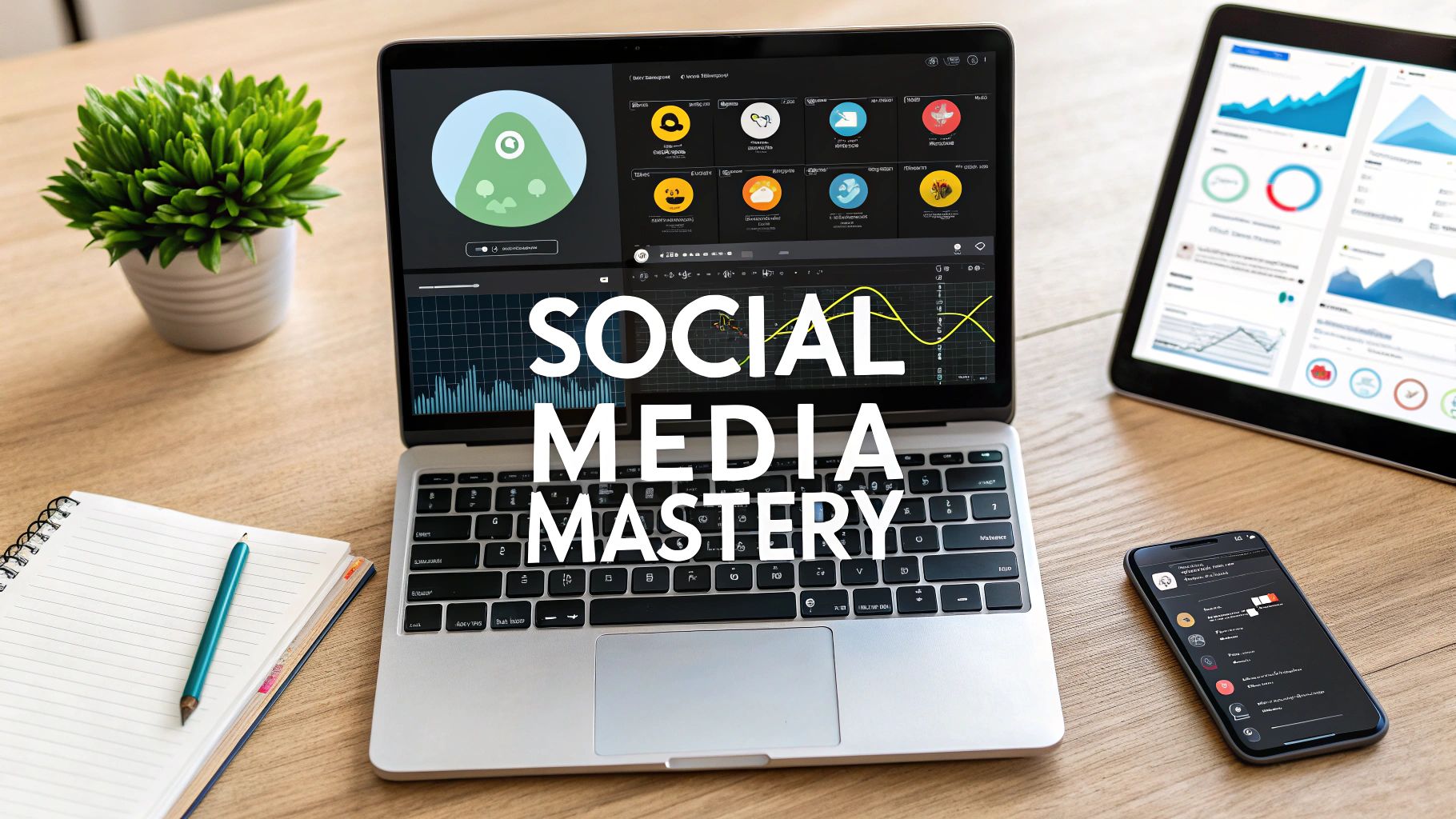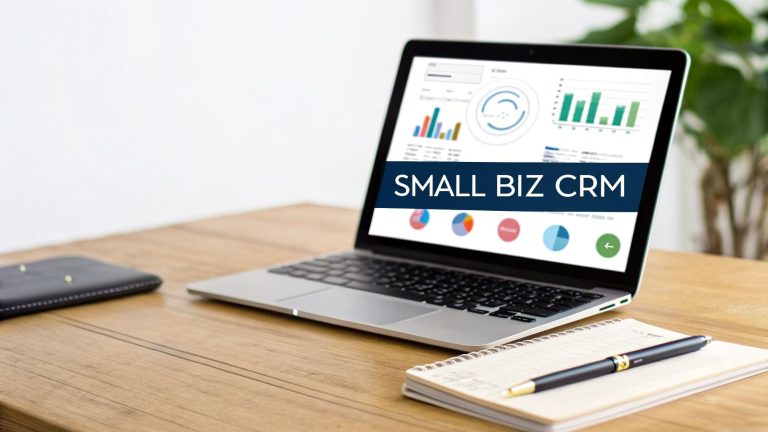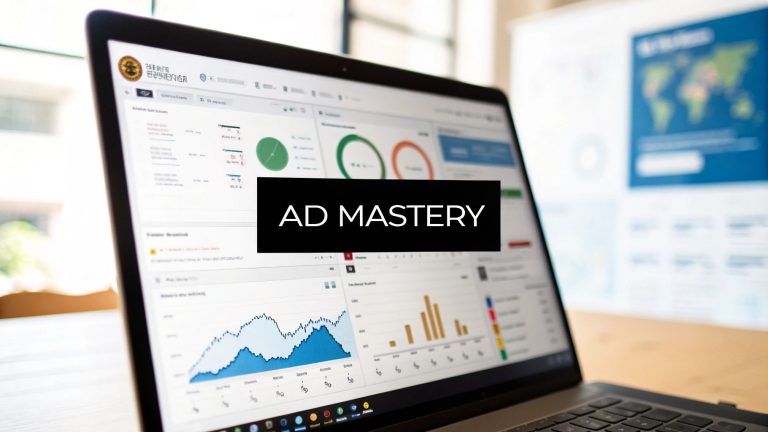A Guide to Managing Multiple Social Media Accounts
Look, trying to manage a half-dozen social media accounts is the new normal. It’s not just for massive corporations anymore; it’s the daily reality for just about every business, marketer, and agency out there.
But that initial thrill of connecting with people on Instagram, LinkedIn, and TikTok? It wears off fast when you’re drowning in a sea of different logins, content formats, and analytics dashboards that don't talk to each other.
This isn't just about being busy. It's about being inefficient, and that chaos actively hurts your brand.
You Can't Just "Post More"
When you don't have a solid system in place, your brand's voice gets muddy. One day you sound one way on LinkedIn, the next you sound completely different on Instagram. It’s confusing for your audience.
Your team gets burned out trying to keep up with the constant demand, and you start missing golden opportunities to actually engage with people. This guide is about moving past the generic "be consistent" advice and actually building a command center for your social media.
It's Time for a Real System
Instead of constantly playing catch-up, the goal is to build a proactive system that works for you. This isn't just about scheduling posts; it’s about strategically managing your entire online presence from one central hub. We're going to focus on a few core strategies to help you get there.
Here's what we'll dig into:
- Bring It All Together: We’ll look at how to pick and use the right management tools to get all your accounts under one roof. This alone will save you countless hours.
- Lock Down Your Assets: I'll show you some simple, straightforward ways to manage team permissions and keep your accounts safe from unwanted access.
- Turn Chatter into Customers: We'll cover how to track what's working and, more importantly, how to build in workflows that capture leads directly from your social channels.
The real problem with managing multiple social media accounts isn't the workload—it's the lack of a unified process. A solid system turns chaos into a predictable, scalable marketing engine.
At the end of the day, this is about creating a framework that supports your goals instead of getting in the way. Once you put these strategies into practice, you can finally stop juggling and start managing with confidence, knowing every single post is working toward a bigger business objective.
Choosing Your Social Media Command Center
The first real step to taming social media chaos is picking your command center. This isn't just about finding software with the longest feature list; it's about choosing a genuine partner for your workflow—a tool your team will actually use every day.
A clunky or confusing interface will kill adoption rates faster than anything. Before you commit, always take advantage of free trials. Pay close attention to how intuitive the dashboard feels. How many clicks does it take to do basic things like scheduling a post or replying to a comment? If it feels like a chore, it's the wrong tool.
What Really Matters in a Management Tool
Beyond a clean look, your decision should hinge on a few non-negotiable features. First up: a unified social inbox. Constantly switching between native apps to answer DMs and comments is a massive time-waster and a surefire way to miss important conversations. Bringing all your messages into one stream is a total game-changer for efficiency.
Another big one is scalability. The pricing plan that fits your budget today might become a bottleneck in six months. Look at how the cost changes as you add more accounts, users, or features. You want a platform that can grow with you, not one that penalizes your success with steep, unexpected costs.
The complexity of managing multiple accounts has led to a surge in businesses adopting management tools. In fact, 80% of mid-sized brands now use real-time dashboards to streamline scheduling, analytics, and reporting.
Comparing the Top Contenders
Different tools are built for different needs. The "best" choice really depends on what you're trying to accomplish. Is your main focus deep analytics and reporting, or is a simple, effective content scheduler more important right now?
To help you decide, let's look at the core strengths of three popular platforms. This quick comparison highlights where each one shines, helping you match a tool's capabilities with your team's specific workflow.
- Hootsuite: An all-around powerhouse, especially great for teams that need robust analytics, social listening streams, and a unified inbox that can handle a high volume of engagement.
- Sprout Social: A premium choice with a heavy focus on in-depth reporting and social CRM features. It's ideal for data-driven teams that need to prove ROI.
- Buffer: Known for its clean, simple interface, Buffer excels at straightforward content planning and scheduling. It's perfect for smaller teams focused on getting content out the door.
For a broader look at different platforms, check out our guide on essential marketing tools for agencies.
Social Media Management Tool Feature Comparison
Choosing the right tool often comes down to the specifics. This table breaks down key features across the big three to give you a clearer picture of what you're getting with each platform.
| Feature | Hootsuite | Sprout Social | Buffer |
|---|---|---|---|
| Unified Inbox | Yes, with advanced filtering | Yes, with CRM-like features | Yes, for engagement and comments |
| Content Scheduling | Yes, with bulk scheduling | Yes, with content calendar and approval workflows | Yes, simple and intuitive queue-based scheduling |
| Analytics & Reporting | Robust, with customizable reports | Best-in-class, deep-dive analytics | Good, focused on post performance metrics |
| Social Listening | Yes, integrated streams | Yes, advanced monitoring and trend analysis | No, not a primary feature |
| Team Collaboration | Yes, with roles and permissions | Yes, with task assignment and approvals | Yes, with user roles and draft posts |
| Best For | Agencies & large teams | Data-driven brands & enterprises | Small businesses & individuals |
Ultimately, the goal is to find a platform that feels like an extension of your team. Whether you need the deep data from Sprout Social, the all-in-one power of Hootsuite, or the simplicity of Buffer, making an informed choice is the first step toward a more organized social media strategy.
If you're still feeling overwhelmed by the sheer number of accounts you're juggling, this visual decision tree can help clarify your next steps.

The flowchart makes it clear: the solution to account overload is a three-pronged approach. You need to centralize your workflow, secure your assets, and measure your results. Each of these pillars is best supported by a dedicated management tool that becomes your single source of truth.
Creating One Content Strategy for Many Platforms

Managing a bunch of social accounts isn't just about being efficient—it's about being coherent. One of the biggest rookie mistakes I see is blasting the exact same post across every single platform. It screams "automation" and completely ignores why people are on LinkedIn versus TikTok in the first place.
The real secret to winning at multi-platform management is building one unified story that you tell in unique, platform-specific ways. This keeps your brand from feeling stale or, worse, out of touch. You're aiming to build a content engine that’s both consistent in its message but flexible in its delivery.
Establish Your Core Content Pillars
Before you even dream of opening a content calendar, you need to lock down your content pillars. Think of these as the 3-5 core themes your brand will own and talk about, day in and day out. They’re the foundation of your entire strategy, making sure every single post serves a purpose.
Let’s say you’re a financial tech company. Your pillars might look something like this:
- Financial Literacy: Breaking down intimidating money topics into easy-to-digest tips.
- Product Innovation: Giving people a peek behind the curtain at new features you're building.
- Customer Wins: Sharing stories of how real people are succeeding with your product.
- Market Insiders: Offering expert takes on the latest economic news and trends.
Once you have these pillars, brainstorming stops being a chaotic scramble for ideas and becomes a structured process. Every post, video, and story has to ladder up to one of these themes. No exceptions.
So many brands treat their social channels like one giant megaphone. But real engagement comes from speaking the native language of each platform while staying true to your brand's core message. Your pillars are the message; the platform is the language.
This framework also makes it way easier to plan out your content themes for months at a time, ensuring you’ve got a good mix that keeps your audience coming back for more.
Adapt and Repurpose Your Content
Here's a little secret: the most productive social media managers aren't coming up with a dozen new ideas every week. They're coming up with one great idea and figuring out how to repurpose it a dozen different ways. This is how you scale content without burning out.
Let's walk through a real-world example. Imagine you just hosted a 60-minute webinar on "Future-Proofing Your Small Business." That's your "hero" asset.
Now, watch how we can spin that one piece of content into a full week's worth of posts:
- LinkedIn: Pull out the key takeaways and write a 500-word article. To make it pop, embed a 2-minute video clip of the most powerful moment from the webinar.
- Instagram: Design a slick carousel post with 5-7 slides, each one highlighting a critical tip with bold graphics. Then, chop up the webinar into three 60-second Reels, each focused on a single, powerful piece of advice.
- TikTok: You don't need fancy production here. Create two short, punchy videos using a trending sound that answers a common question you covered in the webinar. Keep it moving fast and under 30 seconds.
- Twitter (X): Schedule a 10-tweet thread that breaks down the main points from the webinar. Use bullet points, emojis, and tag any experts you mentioned to spark conversation.
Just like that, one hour of effort has been transformed into over a dozen pieces of native content for different platforms. This "hero and spoke" model is the key to managing multiple accounts effectively. It keeps your content quality high while saving a ton of time and resources.
Streamlining Your Daily Social Media Workflow
Once you have your content engine chugging along, your biggest win comes from efficiency. Let's be real: managing a bunch of social media accounts isn't just about pushing content out the door. It's about handling the flood of engagement, mentions, and DMs without losing your mind.
This is where you graduate from basic scheduling to building a genuinely smart workflow.
A truly killer workflow uses automation to take care of the repetitive, predictable stuff, which frees you up for the high-value interactions that actually build relationships. For instance, instead of manually typing out "Our hours are 9-5" five times a day, you can set up a rule in your management tool to fire back an instant reply. It sounds small, but those little wins add up to hours saved every single week.
Build a Proactive Social Listening Dashboard
One of the most powerful tools in your arsenal is social listening. This goes way beyond just tracking mentions of your @handle. A properly set up listening dashboard is like your own personal radar, scanning conversations across the web in real-time.
You can set up dedicated streams to track:
- Brand Mentions: Catch every single time someone talks about your brand, even if they forget to tag you. This is huge for catching feedback you'd otherwise miss.
- Competitor Activity: Keep tabs on what your rivals are up to. What are they posting? What are their customers saying? Where are they getting traction?
- Industry Keywords: Monitor important terms and hashtags in your niche. This helps you spot emerging trends and jump into relevant conversations before they blow up.
This kind of proactive approach means you’re not just sitting back and waiting for notifications. You're actively hunting for opportunities to engage, solve problems, and protect your brand's reputation before a minor grumble turns into a major headache.
The goal of a daily workflow isn't to be chained to your desk 24/7. It's to have systems that filter out the noise, bubble up what's important, and let you make a real impact in just a few focused blocks of time each day.
Automate and Optimize Your Processes
Beyond just listening, modern tools offer some seriously cool ways to automate your daily grind.
For example, many platforms now have AI features that can chew through historical data from all your accounts to pinpoint the absolute best time to post on each network. This takes the guesswork out of timing and makes sure your content lands right when your audience is scrolling.
These systems are absolutely essential if you plan on scaling. As you add more accounts, trying to manage everything by hand becomes a fast track to burnout. By understanding the basics of what is workflow automation, you can build repeatable processes that guarantee consistency and quality, no matter how many platforms you're juggling.
This is how you turn a chaotic, reactive mess into a smooth, proactive social media machine. It doesn't just save you time—it creates a more professional and responsive presence across every single one of your channels.
Protecting Your Accounts and Managing Team Access

The more your social presence grows, the bigger the target on your back becomes. Managing a bunch of social media accounts isn't just about cranking out content; it's a serious security responsibility. Every new platform, every new team member—each one is a potential weak link. You have to get proactive about security.
The first step is dead simple, yet so many people skip it. Turn on two-factor authentication (2FA) for every single account. Seriously. This one action is your best line of defense and will stop the vast majority of unauthorized login attempts cold.
Assigning Roles Without Creating Bottlenecks
A classic mistake I see all the time is giving everyone on the team the same master key to the kingdom. This "all-or-nothing" approach is just asking for trouble—accidental posts, unauthorized changes, or worse, a disgruntled ex-employee with full access.
This is where your social media management tool becomes your best friend. Get granular with its built-in permission settings to create specific roles.
Think about it like this:
- Content Creator: Can draft and schedule posts, but can't hit "publish" without someone else's approval.
- Community Manager: Can jump into the comments and DMs, but can't mess with the scheduled content calendar.
- Analyst: Has read-only access to see performance data, but can't post or edit anything.
- Admin: Holds the keys. This role should be for one or two highly trusted people, max.
This kind of control isn't about micromanaging. It's about giving team members exactly what they need to do their jobs—nothing more, nothing less. It cuts down on risk and keeps the workflow humming along.
A strong password is a good start, but role-based permissions are what truly secure your brand. Limiting access isn't about distrust; it's about creating a system that protects everyone from simple human error.
Maintaining Your Defenses Over Time
Security is never a "set it and forget it" task. It's an ongoing process that needs regular attention to stay effective.
I recommend putting a quarterly security audit on the calendar. Use that time to review who has access to what. The minute an employee or contractor leaves, their access gets revoked. Immediately. This quick check-up is the best way to prevent "ghost access" from old accounts causing problems down the line.
When you're juggling a ton of accounts, especially for setting up 2FA, managing all those SMS codes can become a real headache. For agencies or teams handling dozens of client profiles, services like virtual phone number services for SMS verification can be a lifesaver. It lets you verify accounts without tying them to personal cell phones, keeping business assets separate and making it way easier to onboard new clients.
Measuring Performance and Capturing Leads
Let's be real. All the amazing content and scheduling in the world means nothing if you can't connect it to actual business results. If you aren't measuring your performance, you're just guessing.
The final, crucial piece of the puzzle is turning all that social media data into smart decisions and, more importantly, into revenue.
This is where a good social media management tool with a unified analytics dashboard becomes your best friend. It’s time to move past vanity metrics like follower counts and start tracking the KPIs (Key Performance Indicators) that actually matter to your bottom line.
Key Metrics to Unify in Your Dashboard
To get a true picture of what’s hitting the mark across all your channels, you need to pull your most important metrics into one place. This lets you compare apples to apples and spot trends you’d completely miss by hopping between different platform analytics.
Your dashboard should consolidate metrics like:
- Engagement Rate: This isn't just about likes; it's about how many people are actually interacting with your content relative to your audience size. It's a true signal of resonance.
- Click-Through Rate (CTR): This shows you how many people are interested enough to click the links in your posts. It’s a direct measure of how compelling your call-to-action is.
- Conversions: This is the big one. It tracks how many people took the action you wanted them to, whether that's filling out a form, signing up for a newsletter, or making a purchase.
Calculating your return on investment is what separates social media managers from social media marketers. For a really deep look at this, check out this excellent guide on Measuring Social Media ROI Like a Pro. Having this data is what gets you more budget and proves your value to clients and stakeholders.
Connecting Social Engagement to Business Leads
The fastest way to prove the value of your social media efforts? Show how they generate leads.
Running campaigns like Facebook Lead Ads is a fantastic way to capture contact information from high-intent prospects. But here's where most businesses drop the ball: getting those leads to the sales team instantly.
Manually downloading CSV files is slow, clunky, and a surefire way to let hot leads go cold. This is where automation isn't just a "nice-to-have"—it's a necessity.
The speed of your follow-up is one of the single biggest factors in converting a social media lead. Automating lead delivery from platforms like Facebook directly to your CRM or sales team closes the gap between interest and action.
Imagine a new lead being contacted within minutes of submitting their info, not hours or days later.
By setting up a direct pipeline, you eliminate manual data entry and ensure no opportunity slips through the cracks. It's how you give your sales team the best possible chance to close the deal.
This seamless integration directly links your ad spend to tangible business growth. To get more strategies on this, you can check out our detailed guide on effective social media lead generation. This is how you transform your social media management from a cost center into a powerful, predictable revenue engine.
Navigating the Hurdles of Managing Multiple Social Accounts
Once you start juggling more than one social media account, you'll find a few common questions pop up almost immediately. Trust me, I've been there. Getting the answers right from the start is the difference between an organized, effective workflow and a chaotic mess.
Let's walk through some of the biggest hurdles I see social media managers face and how to clear them.
How Do I Post Everywhere Without Sounding Like a Broken Record?
The absolute fastest way to lose your audience is to copy-paste the same exact message across every single platform. It just doesn't work.
Instead, think of your content using the "hero and spoke" model. You start with one core "hero" piece of content—maybe it's a new blog post, a customer case study, or a short video. Then, you break that down into smaller, native "spoke" content for each network.
For instance, a single blog post could be repurposed into:
- An insightful, text-based summary for a professional discussion on LinkedIn.
- A slick, visually-driven carousel for Instagram highlighting the most compelling stats.
- A quick, high-energy video tip for TikTok or Reels.
The core message remains the same, but you're delivering it in a way that feels natural and expected on each platform. This shows you respect your audience's time and makes your content feel fresh, no matter where they see it.
How Can I Keep My Brand Voice Consistent?
Your brand's voice is its personality, but the tone needs to adapt to the room you're in. It's like how you are fundamentally the same person, but you probably talk to your boss a little differently than you talk to your best friend.
The first step is to create a simple brand voice guide. Define your core personality traits (are you witty, authoritative, friendly, inspirational?). Once that's locked in, create a few tonal guidelines for each platform. LinkedIn might call for a more formal and professional tone, while your Instagram could be way more casual and personal.
A consistent voice is what builds brand recognition, but it's an adaptive tone that builds a real connection. The trick is to know who you are at your core and then just adjust the volume for each audience.
What Are the Very First Steps to Get My Accounts Organized?
When you’re ready to ditch the chaos and move into a proper social media management tool, it can feel overwhelming. Don't try to do everything at once. Just focus on these three immediate actions.
First, get all of your accounts connected and turn on every single notification so they all feed into one unified inbox. Second, set up social listening streams for your brand name and a couple of your key competitors. Finally, create a basic content calendar and get your first week of posts scheduled.
That’s it. This simple setup instantly centralizes your entire workflow, giving you the visibility and control you've been missing.
Stop wasting time manually downloading CSV files from Facebook. LeadSavvy Pro automates the whole thing, sending fresh leads straight to your Google Sheet or CRM the moment they come in. Give it a try for free at leadsavvy.pro.







